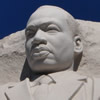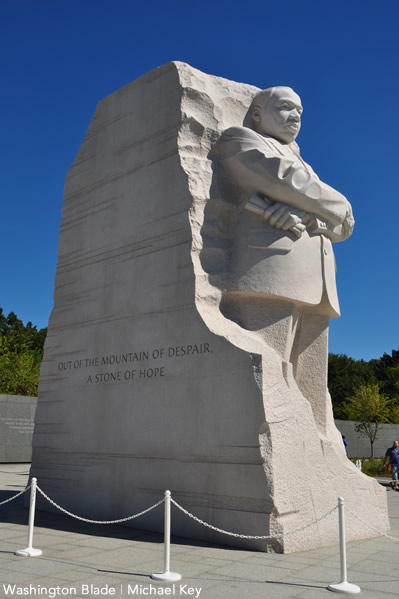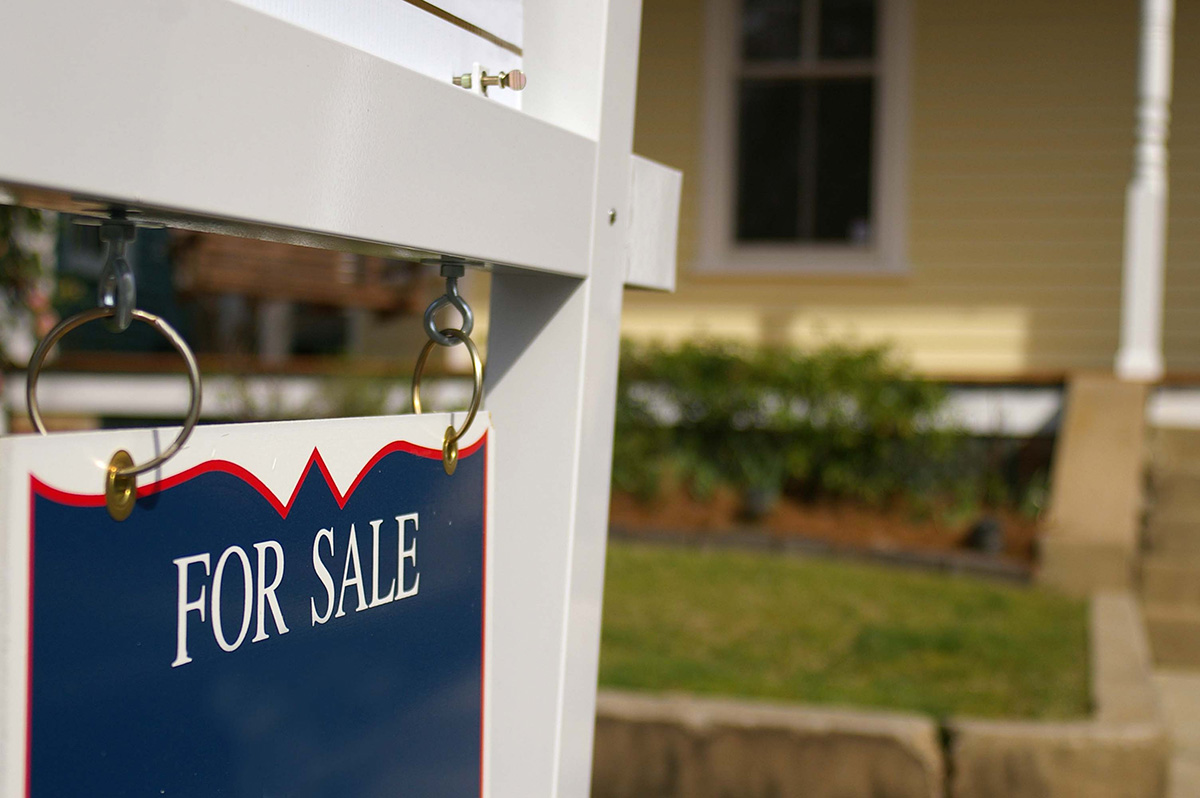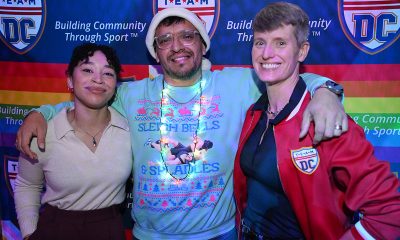Living
A dream fulfilled
MLK memorial, years in the making, resonates with LGBT community


The civil rights movement pioneered by Martin Luther King, Jr., has inspired many leaders of the LGBT movement. (Washington Blade photo by Michael Key)
(UPDATE: The MLK Memorial dedication ceremony has been postponed due to Hurricane Irene. It is expected to be rescheduled for September or October.)
When a tribute to the Rev. Martin Luther King, Jr. is dedicated this weekend, it will mark more than the addition of a new monument to Washington, D.C.’s landscape.
It will symbolize the civil rights leader’s success.
The stone likeness rises as the first monument to a man of color on the National Mall, 48 years after King described his then ground-breaking dream, and in a nation where — at least ostensibly — much of that dream has been realized.
The movement was a model for countless others, including the LGBT rights push, which has shared nonviolence tenets and even leaders like gay, black activist Bayard Rustin.
Yet most similarities end there.
While fruits of the civil rights movement are evident in modern America — apparent in a widening black middle class and a black first family in the White House, for instance — the gay rights movement’s successes have been slower coming.
Same-sex marriage rights remain tenuous and limited to a handful of states; despite hate crime legislation, the threat of violence continues to deny many gays and lesbians a basic sense of safety in their hometowns.
As the nation prepares to welcome King to the National Mall, community leaders share their outlook on the LGBT movement with the Washington Blade — from a California group using civil unrest to humanize the struggle; to the partner of late gay and civil rights icon Bayard Rustin working to keep his ideals alive; to former NAACP leader Julian Bond, who uses his status as a key historic civil rights figure to promote the LGBT rights struggle as a modern civil rights fight.
They point to entrenched faith-based bigotry, and even a lack of movement cohesion, as obstacles. But each believes that by using King’s model of continued struggle, the LGBT dream of full equality can be achieved.
Images of change
The Rev. Martin Luther King, Jr. sitting in an Alabama jail cell. Firefighters battering blacks with powerful jets of water. Jeering whites pouring condiments over the heads of stoic lunch counter protesters.
They’re images that moved activist Robin McGehee, as a child growing up in Jackson, Miss.
And today as executive director of GetEqual, she organizes demonstrations to create actions and images she hopes will drive home the plight of gay and lesbian men and women just as powerfully. An absence of such visual tools encouraged McGehee to form the group, with offices in Berkeley, Calif., and Washington, D.C., in January 2010.
“We had that in reference to the AIDS movement in ACT-UP, and fighting for adequate health care. But in reference to a full civil rights fight for equality, I couldn’t think of one iconic action,” she said.
The group has orchestrated more than 40 actions in the last year, including one in which military veterans handcuffed themselves to the White House fence to protest “Don’t Ask, Don’t Tell.”
The group honed use of such actions at the Highlander Research and Education Center, a New Market, Tenn., center that trained members of the original civil rights movement. McGehee and other LGBT equality activists underwent training at the historic center in January 2010.
“Not until you can give literal imagery to that discrimination do people really resonate or get it,” McGehee said.
Yet despite mirroring the earlier movement’s successful tactics, activists’ success in mainstreaming LGBT rights remains light years behind that of racial equality — something McGehee blames on entrenched religious bigotry.
“We’ve gotten into a moment where people are using the Bible as a weapon,” said McGehee, pointing out that while religious rhetoric once justified slavery and racism, cultural changes eventually erased such thinking. “… I don’t think we’ve jumped that hurdle with regard to gays.”
McGehee is encouraged, however, by more subtle success in incorporating gays and lesbians socially. Just a few years after Ellen DeGeneres thought twice about coming out on TV, realistic portrayals of gays and lesbians are common on TV.
“In time,” she said, “I think we’re gonna get there.”
A life of service

The former partner of Bayard Rustin said the gay civil rights leader would be happy with the arrival of marriage equality, but would have pushed for it in all 50 states. (Washington Blade archive photo by Doug Hinckle)
Walter Naegle had certainly heard of Bayard Rustin, the relentlessly active civil rights agitator who gained as much notoriety for his efforts to win black equality as for his open homosexuality.
But on the day he ran into the civil rights legend on a New York City corner in April 1977, he didn’t recognize him: Rustin wasn’t carrying his trademark walking stick.
“When he gave me his name, I knew,” said Naegle, whose chance meeting with Rustin lead to a 10-year relationship that ended only when the activist died in 1987.
More than two decades later, Naegle keeps Rustin’s ideals alive, working with filmmakers to promote “Brother Outsider,” a portrayal of Rustin’s story, executing his estate and generally overseeing the use of his image.
He believes Rustin’s courage, openness and tireless work — he was in his 70s and still agitating when he died — have helped make him resonate as an icon of the human rights movement.
By the time Naegle met Rustin, the activist had long been a legend. Rustin had worked with A. Philip Randolph to strengthen relationships between blacks and labor unions, but was perhaps best known for his role organizing the 1963 March on Washington.
He’d also become a gay rights icon before it was fashionable: Rustin was essentially outed in 1953 when he was arrested on a “morals charge,” yet he refused to deny the charges or his sexual orientation.
“He didn’t have to hide anything,” he said. “He was just going to be who he was and let the chips fall where they may.”
Rustin would pay the price for that openness.
“Whenever he would rise to a certain level, particularly in the African-American civil rights movement but also in other movements, something would happen and someone would try to chop him down,” Naegle said.
Nonetheless, “He was not defeated. He didn’t turn around and stop his activism — he just worked on the sidelines.”
Rustin remained active with several organizations, including the A. Philip Randolph Institute and the United States Holocaust Memorial Council, at the time of his death.
Years later, his story still has the power to inspire. Naegle said a book of his letters is slated for publication in March, in time for what would have been Rustin’s 100th birthday.
Naegle believes his partner would have been “heartened” to see marriage equality happen in even one state. But he wouldn’t have been satisfied with limited success.
“It’s fine to have these victories in urban areas,” Naegle said. “But people all over the country should be entitled to the same thing.”
“Gay and lesbian rights are not ‘special’ rights”
Julian Bond’s new fight

Former NAACP Chair Julian Bond likens the modern LGBT movement to the push for black civil rights in the ‘60s. (photo courtesy of wikimedia.org)
Where others may see conflict between the black and gay rights agendas, Julian Bond sees similarities.
Both groups struggle against bigotry based on personal characteristics. Both are entitled to basic rights by the same Constitution. And both benefit from each others’ successes.
Indeed, he argues, “People of color ought to be flattered that our movement has provided so much inspiration for others — that it has been so widely imitated,” Bond, who works as an adjunct professor at American University, told the Blade.
The man who has worn many hats as a Georgia lawmaker and leader with both the Southern Poverty Law Center and the NAACP, has more recently directed his outspoken energies to the conflict between civil rights and gay rights advocates.
It’s a particularly touchy dispute. Old school civil rights leaders and even some black gays bristle at LGBT activists’ use of King’s rhetoric to promote their agenda as a modern civil rights movement. Some site racial divisions within the LGBT movement, and argue that discrimination faced by gays isn’t as harsh as that faced by blacks.
Yet for Bond, there isn’t much of a dispute: The two groups must lock arms.
“Many gays and lesbians worked side by side with me in the ’60s civil rights movement. Am I now to tell them thanks for risking life and limb helping me win my rights, but they are excluded because of a condition of their birth?” he said. “That they cannot share now in the victories they helped to win?”
Bond has lent his outspoken rhetoric and organizational skills to many causes over the years.
While a student at Morehouse College, in Atlanta, in the ’60s, he helped organize the Student Nonviolent Coordinating Committee, he was the first president of the SPLC and was board chairman of the National Association for the Advancement of Colored People from 1998 to 2010.
He’s become one of the most vocal mainstream voices in the movement to promote equal treatment for gays and lesbians, going as far as to boycott the funeral of King widow Coretta Scott King in 2006 after the services were arranged at an anti-gay church.
In July, Bond spoke at an NAACP forum discussing gay and lesbian issues in the black community, featuring openly gay black comedian Wanda Sykes and CNN anchor Don Lemon.
“People of color carry the badge of who we are on our faces. But we are far from the only people suffering discrimination,” Bond said. “Sadly so do many others. They deserve the law’s protections and civil rights too.”
Bond’s comments stand in contrast to the black community’s historically conservative stance on gay issues.
Yet he said one need only look at the personal examples set by the lauded civil rights leaders to see whether such thinking is in line with King’s dream.
“We cannot know what Dr. King would have thought about today’s GLBT movements,” Bond said. “But if we consider the prominent role his widow, Coretta Scott King, occupied in speaking out on GLBT rights, it is hard to believe that he would not have done the same.”
Real Estate
In real estate, trust the process
With rates coming down, we could see spring surge in buyers

The average 30-year mortgage rate is falling, little by slowly. With predictions that the rate will continue to adjust downward in the next year or two, there may be a busier spring market than we have seen in the last few year, especially for the DMV market, which has been reeling from thousands of layoffs this past year. The frenzied activity resulting from interest rates close to 3% for some borrowers will probably not occur; however, this spring could add up to be a few notches busier than the last.
What does this mean for buyers and sellers? Lender Tina Del Casale with Waterstone Mortgage says she has seen “low to mid 6’s as the average for conventional loans.” If rates continue downward into the 5% range, there may be more activity than we saw in the last year or two. This could release a little bit of pent up demand.
Many buyers will have found that for whatever reason, their current home is not meeting their needs. Sellers may want to finally take the plunge and put a for sale sign in the yard and online, now that they might find a more reasonable rate on their next home. This winter can be an opportunity to assess financial situations, home conditions, and optimize one’s chances to have a sale with more agreeable terms, or put one’s best foot forward in an offer. In addition to checking with a lender or favorite handy person, let’s review what sellers and buyers typically spend their energy negotiating while enjoying the lovely process called “going under contract”:
- Timelines – Sellers might want to have their house solidly under contract (papers signed, thumbs up from the lenders, all inspection items decided upon and settled) so that they can put an offer down on a new home, and then negotiate that timeline with the other sellers. Remember, making a move is not only about the buyer taking possession of a new home, but also about the sellers figuring out their situation as well.
- Sale Price – unfortunately for buyers, in the eyes of most sellers, “money talks.” So, in a non-competitive situation, a seller might be happy to just get one offer at a price that was within the desired range. As soon as another interested buyer enters the equation, it can become a little bit like RuPaul’s Drag Race, and one will have to lip sync for one’s life, honey! And only one buyer will get to hear the words, “condragulations!”
- Tone/Vibes/Energy in the Room – Remember: Human beings are emotional creatures. All of us have feelings. And all of us want to put energy into situations where we feel appreciated, where a level of self-awareness exists, and a sense that each side is trying one’s hardest to act in good faith. The best transactions I saw were where a little grace was the “grease on the wheels” of the transaction. Occasionally, a buyer had cold feet and wanted to see the unit a few more times before the settlement date, or a seller forgot to scrub the bathroom with a little extra elbow grease before the settlement date. Life happens; misunderstandings can occur. A wise therapist once said: “You don’t have to like it, but can you allow it?” The tone of one or both parties in the transaction can be what seals the deal, or results in one party exiting the contract. (In the case of the dirty bathroom, the seller left a check with the title company for the buyer to pay a housekeeper to come clean what they couldn’t.)
Joseph Hudson is a referral agent with Metro Referrals. He can be reached at 703-587-0597 or [email protected].
Real Estate
Signs you’ve outgrown self-management of your D.C. rental
Keeping up with local regulations is a struggle

According to rental market statistics from RentCafe, Washington, D.C., remains at the top of the most popular cities for rental properties. With a strong rental market and a growing population, success should be second nature to real estate investors and rental property owners in this area.
As a self-manager of your own rental, if you’re not enjoying the profitability and the earnings that this market can provide, it might be time to look for professional management.
There are certain signs that show property owners have outgrown self-management. We’re exploring those today, and inviting DIY landlords to consider the benefits that come with a partnership with a professional property management company in Washington, D.C.
Washington, D.C., is known for having a complex and ever-changing regulatory environment. There are strict tenant rights, rent control laws, and specific rules related to property maintenance such as mold, lead based paint hazards, among others. The Rental Housing Act of 1985 is strictly enforced, and under this program, there are specific rules regarding rent adjustments, dispute resolution, and eviction protections.
Fair housing laws need complete compliance, security deposits have strict timelines, and habitability standards are in place to ensure tenants are living in a home that’s safe and well-maintained.
Staying on top of these rules can be time-consuming and difficult. Violating even a small regulation unintentionally can result in fines or legal action. It’s critical to stay compliant, and if you find yourself struggling to keep up with the evolving laws and regulations, it’s a clear sign that you may need professional help. Property managers can reduce the risk and liability of making a legal mistake.
Financial Returns are Underwhelming
A lot of self-managing landlords choose to lease, manage, and maintain their own properties because they don’t want to pay a management fee. We get it. Keeping more of your money seems like the best way to increase profitability.
But, here’s the reality of it: property managers can help you earn more and spend less on your investment, increasing your earnings and your ROI. In fact, a good property manager can often earn enough additional net revenue for the owner to pay for that fee over a year.
Property managers are experienced at maximizing the financial performance of rental properties. We can help:
- Optimize rental income
- Reduce vacancy rates
- Lower maintenance costs through established vendor relationships
- Recommend improvements for higher values
Ultimately, a good property manager will ensure that your property is being run efficiently. We will use our expertise to ensure your property is earning what it should.
Maintenance and Repairs Are Taking Up Too Much Time
Maintenance challenges are not unique to self-managing rental property owners. We deal with them, too, as professional property managers. We respond to plumbing issues and appliance malfunctions, we take calls in the middle of the night when a sewer is backing up, and we work hard to protect properties against deterioration and general wear and tear.
This can be overwhelming, especially when it comes to finding vendors and service professionals that are both affordable and provide quality service. Plumbers, electricians, HVAC technicians, and even landscapers and cleaners are in high demand in Washington, D.C. But maintenance at your rental property cannot wait. It’s essential to the value and condition of your investment as well as to the product you are selling.
It’s time to work with a professional property manager if you’re having trouble finding vendors or if you’re struggling to keep up with maintenance requests. We have systems for emergency responses, routine repairs, and preventative services.
Tenant Screening Is Becoming More Difficult and Time-Consuming
Finding good tenants is one of the most critical aspects of rental property management. But in our home of Washington, D.C. we have one of the most regulated rental markets in the country. The tenant screening process has become increasingly complex, highly restricted, and time-intensive.
Many property owners are surprised to learn that there are more limitations than ever on what can be screened, what information can be used in making a decision whom to rent to, and how screening decisions must be documented. Federal and local laws tightly regulate the use of credit histories, criminal background records, income verification, and even eviction records. Staying compliant is not optional. Failure to follow these rules can open the door to discrimination claims, administrative complaints, substantial fines, or even lawsuits.
That’s why rushing or relying on outdated methods can easily result in selecting the wrong resident or worse, unintentionally violating DC’s Human Rights Act or federal Fair Housing laws.
Problematic tenants often become evident only after move-in: lease breaks, chronic late payments, noise complaints, and property damage. When these patterns appear repeatedly, it is often a sign that the screening process is not sufficiently structured.
Why Professional Screening Matters
Professional property managers have systems in place to perform thorough, legally compliant screening while avoiding oversteps that could violate the regulations. Professional property managers use trusted screening platforms and follow written processes that keep owners protected and ensure fairness for applicants.
Columbia Property Management’s screening process includes:
- Credit Report Review
Evaluating credit patterns, payment reliability, and debt load while complying with restrictions on how data can be used. - Rental History Verification
Contacting prior landlords and reviewing national eviction databases—keeping in mind that some jurisdictions like the District of Columbia limit how far back eviction data can be seen, must less considered. - Background ChecksReviewing public records in a manner consistent with DC’s Human Rights Act and federal guidance on criminal history usage. Not all criminal records can be considered in rental decisions, and timing rules often apply.
- Income & Employment Verification
Confirming applicants can afford the rent and other monthly expenses based on their income, without ruling out certain income in a discriminatory way (e.g., vouchers, subsidies, or lawful alternative forms of income). There are many intentional steps conducted by professional property managers under a framework that ensures decisions are based on objective criteria, applied consistently, and fully aligned with the latest federal and DC regulations.
Your Property Is Sitting Vacant for Longer Periods
While current rental market dynamics are starting to show the effects of federal workforce layoffs and the worsening local economy, the vacancy rate in Washington, D.C., is relatively low, compared to the national average. According to a news report from WTOP, the local vacancy rate is just 6%, and there are an average of seven applications for every available rental unit.
A vacant rental property can quickly become a financial drain. Whether you own a condo near Dupont Circle or a single-family home in one of Capitol Hill’s neighborhoods, every day your property sits empty means lost income. While the D.C. market is generally competitive, the reality is that there are always fluctuations in demand based on seasons, neighborhood desirability, and even economic trends.
If you’re struggling to fill your rental quickly, it might be a sign that you need to re-evaluate your approach. An experienced property management company has a marketing strategy in place to keep vacancy periods as short as possible. From professional photos and listings to leveraging established networks, they can help ensure that your property is rented quickly, reducing the amount of time it sits vacant.
While managing a rental property in Washington, D.C., can be rewarding, it’s also challenging. As your property portfolio grows or the demands of your life or the demands of being a landlord increase, it’s helpful to recognize when it’s time to step back and let a professional handle the day-to-day tasks.
From navigating complex local regulations to ensuring your property remains occupied and well-maintained, there are many reasons why rental property owners in Washington, D.C., outgrow self-management. If any of these signs resonate with you, consider partnering with a property management company like ours to ensure that your rental investment continues to thrive without the stress and burnout of self-management.
We’d love to be your Washington, D.C., property management partner and resource. Please contact us at 888-857-6594 or ColumbiaPM.com
Scott Bloom is owner and Senior Property Manager, Columbia Property Management.
Advice
My federal worker husband is depressed and I don’t know how to help
I feel like he’s dragging me into his hopelessness

Dear Michael,
My husband is a federal worker. Many of his colleagues took “the fork” or have been fired. So work has been overwhelming. He usually works late. The morale in his office is terrible. His paycheck disappeared with the shutdown although due to the specifics of his job, he still had to go in. He’s gotten increasingly depressed, irritable, and short-tempered.
I met Jason 20 years ago when we were young, and one of the things that made me fall in love with him was his idealism. He came to Washington because he wanted to contribute to the well-being of our country.
When I look at him now, it’s like he’s been through the wringer. He’s lost his idealism, feels unappreciated by our country, and is becoming bitter.
He never wants to go out with friends. Either he doesn’t want to hear them complain about the same sorts of things he’s experiencing, or he doesn’t want to have to interact with people who are doing just fine, job-wise.
He also doesn’t feel like going out, just the two of us. So we’re home a lot. But we’re not spending time together when we’re at home. He’s surfing the internet, doom-scrolling, or playing video games.
I can’t get him to talk to me; he says, “I don’t want to talk about anything, it just makes me feel worse.” I can’t get him to do anything that might help him feel better. He doesn’t want to cook dinner with me, he doesn’t want to eat any of his favorite foods that I make for him, he won’t go for a walk with our dog (exercise is supposed to help mood, right?).
I’m really worried about him. Clearly, he’s depressed, and nothing I am trying is helping him to feel better.
But in addition, I am starting to get annoyed. How much more can I try to do things for him that he doesn’t respond to and doesn’t appreciate?
I’ve been OK through this long slog, so far, but now I feel like I am being sucked into his depression and hopelessness. I’m starting to feel like giving up. I’m lonely and I miss my husband and I am despairing that he’s ever really going to come back.
In short, now I hate my life, too.
I’m not going anywhere but I am worried that my main feeling toward him is starting to be apathy. Is there something I can do to help him that I haven’t thought of?
Michael replies:
I’m sorry, this is such a rough time.
It’s understandable that when someone you love is suffering and feeling miserable, you might at times get fed up and feel like pulling away.
There’s a great saying by an ancient Jewish sage, Rabbi Tarfon: While you can’t fix the whole world, that doesn’t mean you should give up and do nothing to help.
I thought of that saying as I read your letter, because while you can’t get Jason to change his mood or take action on his own behalf, you may have some ability to help him.
Similarly, while you can’t have a fantastic time in life when your husband is in a miserable place, you can take care of yourself and likely have a better life than you are having at present.
For starters, I encourage you to keep reminding yourself that this is without doubt one of the hardest periods of your husband’s life. So it’s a very good idea to have an open heart and a lot of compassion for Jason, as much of the time as you can. This won’t be easy. Strive to keep in mind that getting angry at Jason or frustrated with him won’t help.
Don’t try to insist that Jason do anything. Often, when we push someone to do something that they don’t want to do, this just results in their digging in more. People generally don’t like to be nagged.
Of course you can ask Jason if he’d like to join you for a walk, or an outing, but tread carefully. You can advocate for what you’d like, but Jason gets to decide what he wants to do.
You can certainly ask Jason what he would like from you, especially when he’s complaining. I love the “3 H’s” concept: Would he like you to hear (simply listen)? Would he like help (advice on what to do)? Or would he just like a hug?
The best message you can send to Jason, by your presence and by an ongoing loving stance, is “I am here. You’re not alone.” Even when he wants to stay in the basement playing video games. You’re not criticizing him and you’re not judging him. Maybe you’re baking some cookies you both like and leaving him a plateful to eat if and when he wants to. (Be sure to treat yourself to some, as well.)
In terms of bigger interventions, you can suggest that Jason meet with a therapist, or meet with his physician to discuss the possibility of an antidepressant to help him through this awful period. For example, you might have a sincere conversation where you say something like this:
“I’m worried about you. I really want to encourage you to get some help. My love for you can only go so far, and while I’m not going anywhere, I’d like you to take seriously how miserable you are. I’m here to encourage you that maybe you could feel better, even though your circumstances are terrible and you feel disillusioned.”
Again, trying to convince or force Jason to take action will likely go nowhere useful.
Now let’s focus on you. Living with a depressed spouse can be a miserable, soul-crushing experience. As you described, you’re watching the person you love suffer, and you’re pretty much losing your partner in so many of the things that make life enjoyable.
Part of getting through this is to acknowledge that there is a limit to what you can do for Jason. And part of it is to strengthen your commitment to self-care. Taking care of yourself may keep you from going too far into misery or resentment. He doesn’t want to get together with a friend? Consider going anyway, and do your best to have at least a good time. Same thing with a dog walk, a good meal, or sitting down to watch a movie you’d like to see. You might also consider meeting with a therapist for ongoing support and strategizing.
While this period of your life is gruelingly difficult, try to remember that it likely will come to an end, that there will likely be good times ahead for you and for Jason, and that in the meantime, doing your best to find ways to take care of yourself while also being a supportive and loving spouse will help you to survive.
Michael Radkowsky, Psy.D. is a licensed psychologist who works with couples and individuals in D.C. He can be found online at michaelradkowsky.com. All identifying information has been changed for reasons of confidentiality. Have a question? Send it to [email protected].


















